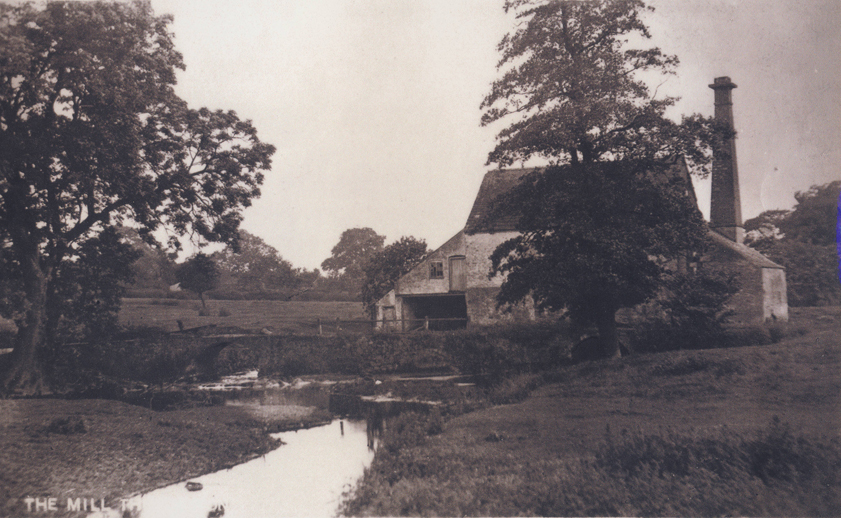
Thurcaston Mill in the 1890s
The mill stood on the west side of Mill Road, just north of Lanesborough Drive.
The Water Mill
Thurcaston has enjoyed the benefits of a mill to grind the locally grown corn since Saxon times. It was recorded in The Domesday Book of 1086, valued at 3 shillings.
The mill, driven by the Rothley Brook (known as "Our Brook") was an undershot type with the water running below the wheel.
In 1869 it had 3 pairs of millstones. Later, a steam engine and chimney were added.
The mill ceased operation around the end of the First World War. It then stood unused until it was destroyed by a fire, thought to have been caused accidentally by village youths. It was demolished in the 1920s.
The mill race, pond and the cobbled path to the mill can still be identified if sought before the grass and weeds have grown too high in the year.
The Lord of the Manor
The mill was owned by the Lord of the Manor. Villagers were obliged to grind their corn there and pay for its use.
They also had to use a communal oven to bake their bread for a further charge.
Oven Cottage
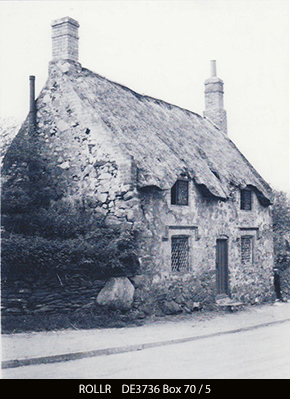
Oven Cottage
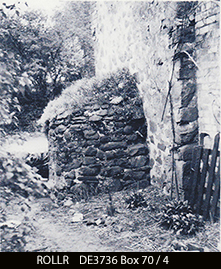
Oven at side of cottage
The oven attached to the side of the house was about six feet high and wide.
When the cottage was pulled down in 1960, huge granite blocks were revealed, possibly left by glaciers in the last Ice Age. Its exact position is marked by one of these ‘glacial erratics'. It can be seen in the photograph of the cottage above and is now incorporated into the retaining wall (see picture below).
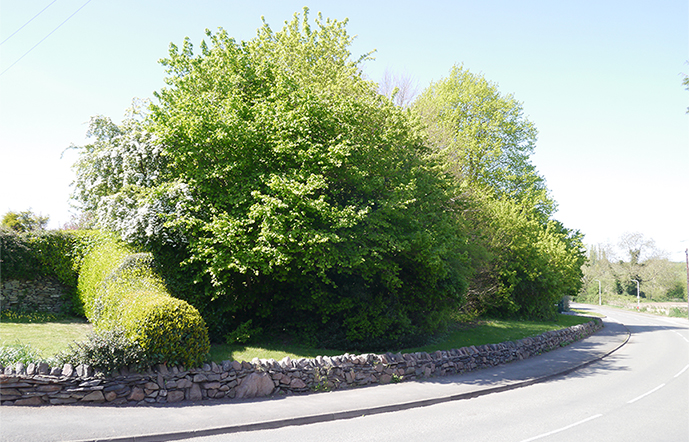
Site of Oven Cottage
Dispute about water levels
At the time of the Thurcaston Enclosure in 1798 there was an ongoing dispute between the owner of the mill, Augustus Richard Butler Danvers, and other nearby landowners. The height of the banks and flood gates by the mill had been raised, resulting in land upstream being flooded. The Thurcaston Enclosure Act directed the Commissioners to include a resolution of this dispute with their other work.
The Commissioners instructed Butler Danvers to maintain the level of the brook at a lower level by reducing the height of the floodgates and by creating a weir to divert any surplus water into the original course of the brook.
The part of the weir which crossed the brook has since been demolished. Today, the brook follows its original winding course at its natural level. Water flows from the mill pool below the mill at times of flooding.
Millers
The first named water miller was Richard Corbett of Cropston in 1600, found in the Bradgate Estate Archives, 1600 – 1699. An entry in the Burial Register records Ellin, his widow, died in 1633 and his son, Thomas died in 1639.
Also included in Thurcaston’s Burial Records is an entry in 1715 for Thomas Porter, Miller.
John Dexter was the next miller to be recorded in 1841, followed by a sale of goods at the mill in 1844. In 1846 John Blackwell is identified as the miller, then Henry Johnson in 1855 and Charles Harding in 1861. Harding lived in Leicester and advertised for
‘a stout active man, as Miller’s carter, to manage two horses… a good character required’. 1
Richard Gaut was listed in the Census Return for 1861 as the miller. He employed a carter named Samuel Wagstaff. In 1864 F.G. Turpin, whose marriage was announced in the Leicester Chronicle in 1865, was the tenant.
Robert Scott took over the business soon after, but after two dry seasons he gave up the tenancy which was then taken up by James Pollard. Pollard soon discovered that Scott had failed to pay his Tythe Rent of £15.0s. 3d., and had paid it himself. He now sued for its recovery from Scott ‘who was a person who had been frequently before the court’.2 The Magistrate ordered an immediate payment.
October 1869 saw two advertisements in various newspapers. The first was ‘as instructed by R. E. Scott of Thurcaston Mill (who is under notice to quit) to sell by auction……)’ 3 There follows a list of livestock dated Friday October 22nd 1869. The second advert stated
‘To Let, a Water Mill driving three pairs of stones in first rate working order, and on a good stream. Apply Mrs. R. E. Scott, Thurcaston Mills, Loughborough.’4
A further item published in ‘The Economist’ newspaper in 1869 stated that R.E.Scott, Thurcaston Mills Leicester, Miller, was registered as a company on December 1869.
A more settled period began with the arrival of L. Hopkinson in 1870.There seems to be some doubt over his first name which is variously recorded as Lenford, Denford, Leonard and Linford.
Problems with Weights
Hopkinson fell foul of the law in 1874 when he was
‘charged with having six weights on his premises, which were unjust. Defendant said he did not use the weights. Supt. John Moore spoke of finding the weights on the defendant’s premises at Thurcaston. One 56lb weight was an ounce and a half light. Nine other weights were produced, and six of them were light. Defendant said the weights were simply old iron and had not been used for two years. Fined 5s. inc. costs or 3 days imprisonment.’5
Various bakers in the surrounding villages supplied bread to the Union Workhouse at Rothley where, in 1875, it was noted in that the scales and weights at Thurcaston, used for weighing the bread were ‘out of repair’, and asking that they might be sent to Loughborough to be made correct.
As well as milling, Mr. Hopkinson had also worked as a farmer and grazier before selling off his livestock and agricultural implements in 1886.
The Water Mill was acquired by John Payne in 1888. He was also a farmer.
Steam engine added
The business was taken over by his son, James Leonard Payne in 1900. He was identified in a Trade Directory as a corn and coal merchant. This might be an indication of the date of the installation of a steam engine in the mill. James remained in charge of the mill until 1916 when he was listed in Trade Directories only as a farmer.
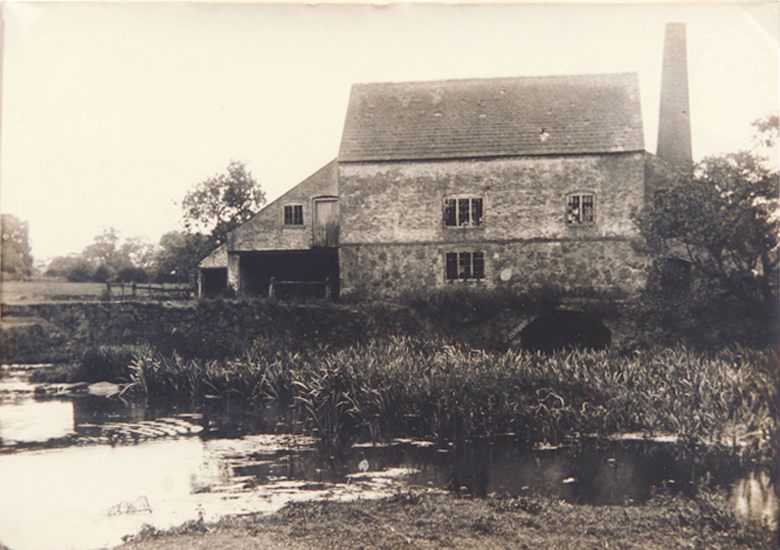
Thurcaston Mill, derelict
© Brenda Hooper 2020
Acknowlegements and Sources
The pictures of Oven Cottage and the oven at its side are used here by kind permission of The Record Office for Leicestershire, Leicester and Rutland (ROLLR).
1 Stamford Mercury, Friday, 9 June 1865
2 Norfolk Chronicle, Saturday, 23 February 1867
3 Leicester Journal, Friday 18 September 1869
4 Stamford Mercury Friday 29 October 1869
5 Leicester Journal, Friday 18 September 1874